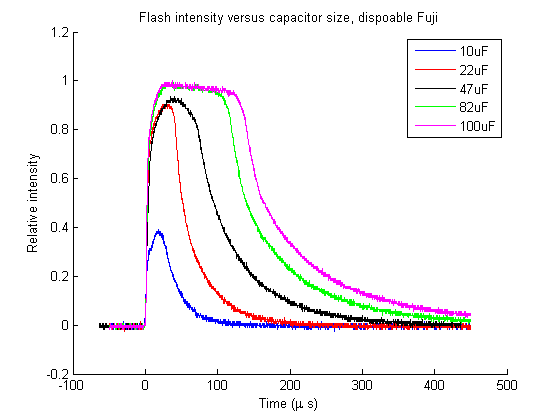Freezing the Motion of a Bee Wing
I’m taking a break from the shutter design (it happens every time I have to spend money to build a prototype) to explore a bit the issue of illumination. Currently my number one choice is to build an array of short-duration flashes made from disposable camera parts. This should be relatively cheap, as there are places where you can buy them in bulk—or even buy just the circuit boards.
Sam recommended that the first test I should do to try to shorten the flash duration is to simply use a smaller capacitor. So I took one of the disposables I have—a Fuji, I think—and did just that. The camera had a 100μF capacitor on it; I tested along with that 10, 22, 47, and 82μF. None of them were anything special—just high voltage (at least 350V) electrolytics.
To do the tests, I resoldered the capacitor, then fired the flash (from about the same distance every time) toward a light meter much like the one on Sam’s site. The distance and angle were not always exactly the same, but it was certainly sufficient to check for basic behavior. The results are shown below (normalized to the maximum intensity of the largest capacitor).

As you can see, the minimum usable flash duration I got was with the 22μF capacitor, and is somewhere between 50 and 75 μs (this would obviously depend on the optical system and the exposure curve of the film). With the 10μF capacitor, the flash does not reach its peak output. At 22μF the peak output is not as high as with the stock 100μF capacitor, but I figured I would be making a large array of these anyway (and focusing them as best as I could). If I cared, some pulse-shaping electronics (inductors) could make the pulse much sharper, but I doubt its “tail” would influence the image all that much.
These preliminary tests were easy to do. But is this pulse duration short enough? According to “The Aerodynamics of Hovering Insect Flight. III. Kinematics” by C. P. Ellington (Philosophical Transactions of the Royal Society of London. Series B, Biological Sciences, Vol. 305, No. 1122, Feb. 24 1984, pp.41-78), the honey bee Apis mellifera flaps its wings through a 131-degree arc at 197 Hz. Ellington’s measurements show that during the stroke, the velocity of the wing tip is nearly constant. For the sake of calculation, if we assume a 120-degree stroke at 200 Hz, then over 1/400th of a second the wing swings 120 degrees. Since the velocity is constant, we can say the wing tip is like the edge of a solid disk rotating at 400 x 60 / 3 = 8,000 RPM. According to this site, the length of the bee wing is 9mm or greater (we’ll say 10). So the velocity of the wing tip through this constant-velocity stroke is 10 / 1000 x 2 x Ï€ x 400 / 3 = 8.4 meters per second (19 miles per hour).
So if the exposure time is 1 millisecond, the wing will “move” 8.4 mm—an awful amount of blur (one down or up stroke takes 2.5 milliseconds, if the beat fequency is 200 Hz). At 50μs, this is reduced to 0.42 mm. Not bad!
But these pictures will be big. If the magnification is 1:1, then the wing’s image is also moving 420 microns on the film plane, but if it’s 2:1 (as is likely it may end up being) then the wing moves 840 microns—almost 1 mm. A high-end film scanner these days can achieve 4800 DPI. Typically, the pictures will be printed at 300 DPI (for 6×6 film, this comes out to a 38×38 inch print) which is a magnification factor of 16. That means for a 1:1 camera the wing blur will be almost 8 mm and for a 2:1 camera almost 16 mm. In both cases, this will be about 4% of the size of the bee’s wing on the print. In a worst-case scenario, having multiple flashes firing at once (and not being identical), I’d say we can expect an exposure time of some 75μs, which brings the blur up to 6 to 8% of the bee’s wing.
The nice thing about all this is that bees flap their wings unusually fast for their size. Other insects of that size will flap much slower. Bumble bees flap around 150 Hz, but, for example, the crane fly Tipula obsoleta flaps at around 60 Hz.
It’s hard to judge how sharp the image through the lens is in these terms—but you can bet with a high-end lens the image of a point source will be well below 400 microns. In other words, the motion blur will be discernible in the image. Still, these results are encouraging, because with the 2:1 camera (and the 16x printing enlargement), there’s 16mm (some 5/8 inch) of blur on a bee that is probably around 60 centimeters (almost 2 feet) long on the image.
I think next I’ll try a few other tricks to shorten the pulses, then maybe go on and try to build the array and start measuring (with a photographic light meter) how much usable light I can get out of them.
Free Email Dating Service
Single Night Club
Online Dating Service Uk
Top Online Dating Service
Valentines Day Dating Game
Speed Dating Clapham
Single Web Site
Dating Sexy Girl
Asian Female Single
Sea Of Love Dating Service
About this entry
You’re currently reading “Freezing the Motion of a Bee Wing,” an entry on Insect Camera
- Published:
- 02.06.08 / 7pm
- Category:
- Flash
Comments are closed
Comments are currently closed on this entry.